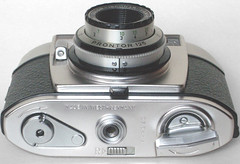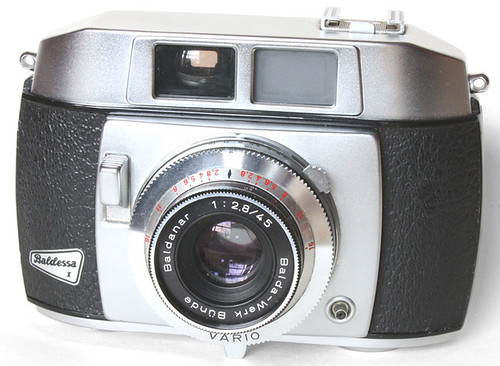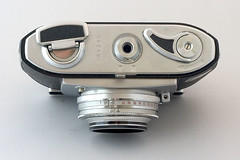Difference between revisions of "Baldessa"
Hanskerensky (talk | contribs) m |
(some pics CP -> CW; others invited; missing attributions & rights added to all; layout fixes) |
||
| Line 1: | Line 1: | ||
{{stub}} | {{stub}} | ||
| + | |||
{{Flickr_image | {{Flickr_image | ||
| − | |image_source= http://www.flickr.com/photos/awcam/3087410737/in/pool- | + | |image_source= http://www.flickr.com/photos/awcam/3087410737/in/pool-camerawiki |
|image= http://farm4.static.flickr.com/3233/3087410737_13779b48e5.jpg | |image= http://farm4.static.flickr.com/3233/3087410737_13779b48e5.jpg | ||
| − | |image_align= | + | |image_align= right |
|image_text= Baldessa, c.1964<br>[[Isco|Isco-Göttingen]] Color-Isconar,<br>45mm/2.8 in [[Prontor]] 125 shutter | |image_text= Baldessa, c.1964<br>[[Isco|Isco-Göttingen]] Color-Isconar,<br>45mm/2.8 in [[Prontor]] 125 shutter | ||
| + | |image_by=AWCam | ||
| + | |image_rights=wp | ||
}} | }} | ||
| − | + | The '''Baldessa''' is a range of comparatively cheaply-made [[35mm]] [[viewfinder camera|viewfinder]] and [[rangefinder camera]]s produced by [[Balda]] in Germany from c.1957 to the late 1960s<ref>{{McKeown}}, pp.96-7</ref>. | |
| − | The '''Baldessa''' is a range of comparatively cheaply-made [[35mm]] [[viewfinder camera|viewfinder]] and [[rangefinder camera]]s produced by [[Balda]] in Germany from c.1957 to the late 1960s<ref>{{McKeown}}, pp.96-7</ref>. | + | |
| + | |||
| + | __TOC__ | ||
| + | |||
| + | Baldessas have an unusual folding [[film advance]] key in the base - requiring a 180° turn, along with a spring-out rewind crank. On the simpler models, this along with the front-mounted shutter release and the frame counter to the left of the viewfinder [[ocular]] leaves the top plate empty except for the accessory shoe. Early models have a removable back; later examples are hinged. | ||
| + | |||
| + | |||
{{Flickr_image | {{Flickr_image | ||
| − | |image_source= http://www.flickr.com/photos/awcam/3087411143/in/pool- | + | |image_source= http://www.flickr.com/photos/awcam/3087411143/in/pool-camerawiki |
|image= http://farm4.static.flickr.com/3246/3087411143_e8e3631105_m.jpg | |image= http://farm4.static.flickr.com/3246/3087411143_e8e3631105_m.jpg | ||
| − | |image_align= | + | |image_align= left |
|image_text= Baldessa base, showing winder<br>(unfolded) and rewind crank | |image_text= Baldessa base, showing winder<br>(unfolded) and rewind crank | ||
| + | |image_by=AWCam | ||
| + | |image_rights=wp | ||
}} | }} | ||
| − | {{ | + | {{brl}} |
===Baldessa I=== | ===Baldessa I=== | ||
{{Flickr_image | {{Flickr_image | ||
| Line 22: | Line 33: | ||
|image_align= right | |image_align= right | ||
|image_text= Baldessa I, 1958 model with Baldanar<br>lens in Vario 25/50/200+B shutter | |image_text= Baldessa I, 1958 model with Baldanar<br>lens in Vario 25/50/200+B shutter | ||
| + | |image_by=AWCam | ||
| + | |image_rights=wp | ||
}} | }} | ||
The '''Baldessa I''' was introduced in 1957 with a [[Isco|Westanar]] 45/2.8 lens in a [[Prontor]]-SVS shuttter. It was updated in 1958 to have a bright-line finder, with a second window to illuminate the frame. This model has a Baldanar, [[Isco|Color-Isconar]] or Westanar 45mm/f2.8 lens in a 3-speed [[Vario]], [[Pronto]], Prontor 125 or Prontor-SVS shutter. The base has a film reminder fitted around the tripod bush, and the rewind release is angled out to form a foot for standing on a horizontal surface. | The '''Baldessa I''' was introduced in 1957 with a [[Isco|Westanar]] 45/2.8 lens in a [[Prontor]]-SVS shuttter. It was updated in 1958 to have a bright-line finder, with a second window to illuminate the frame. This model has a Baldanar, [[Isco|Color-Isconar]] or Westanar 45mm/f2.8 lens in a 3-speed [[Vario]], [[Pronto]], Prontor 125 or Prontor-SVS shutter. The base has a film reminder fitted around the tripod bush, and the rewind release is angled out to form a foot for standing on a horizontal surface. | ||
| + | {{br}} | ||
===Baldessa 1a=== | ===Baldessa 1a=== | ||
The Baldessa 1a was introduced in 1958, and adds a [[rangefinder (device)|coupled rangefinder]] to the Baldessa I design. It was available with a Color-Westanar or Baldanar 45/2.8 lens in a Prontor-SVS shutter. | The Baldessa 1a was introduced in 1958, and adds a [[rangefinder (device)|coupled rangefinder]] to the Baldessa I design. It was available with a Color-Westanar or Baldanar 45/2.8 lens in a Prontor-SVS shutter. | ||
| Line 31: | Line 45: | ||
|image_source= http://www.flickr.com/photos/stevemphoto/256564420/in/pool-camerapedia/ | |image_source= http://www.flickr.com/photos/stevemphoto/256564420/in/pool-camerapedia/ | ||
|image= http://farm1.static.flickr.com/85/256564420_85cc351211.jpg | |image= http://farm1.static.flickr.com/85/256564420_85cc351211.jpg | ||
| − | |image_align= | + | |image_align= right |
|image_text= Baldessa 1B, c.1958 | |image_text= Baldessa 1B, c.1958 | ||
| + | |image_by=SteveMPhoto | ||
| + | |image_rights=nc | ||
}} | }} | ||
The '''Baldessa 1B''' has an added uncoupled [[selenium meter|selenium light meter]] and coupled [[rangefinder (device)|rangefinder]]. Design was by [[Karl-Heinz Lange]]. | The '''Baldessa 1B''' has an added uncoupled [[selenium meter|selenium light meter]] and coupled [[rangefinder (device)|rangefinder]]. Design was by [[Karl-Heinz Lange]]. | ||
| + | |||
{{Flickr_image | {{Flickr_image | ||
|image_source= http://www.flickr.com/photos/stevemphoto/256564370/in/pool-camerapedia/ | |image_source= http://www.flickr.com/photos/stevemphoto/256564370/in/pool-camerapedia/ | ||
|image= http://farm1.static.flickr.com/91/256564370_68e5839d47_m.jpg | |image= http://farm1.static.flickr.com/91/256564370_68e5839d47_m.jpg | ||
| − | |image_align= | + | |image_align= left |
|image_text= Baldessa 1B base<br>winder stowed;film<br>reminder around tripod bush | |image_text= Baldessa 1B base<br>winder stowed;film<br>reminder around tripod bush | ||
| + | |image_by=SteveMPhoto | ||
| + | |image_rights=nc | ||
}} | }} | ||
| − | {{ | + | {{brl}} |
===Baldessa F=== | ===Baldessa F=== | ||
The Baldessa F models have a [[flashbulbs|flashbulb]] holder built-in to the top plate. | The Baldessa F models have a [[flashbulbs|flashbulb]] holder built-in to the top plate. | ||
Revision as of 20:49, 8 August 2011

|
| Baldessa, c.1964 Isco-Göttingen Color-Isconar, 45mm/2.8 in Prontor 125 shutter image by AWCam (Image rights) |
The Baldessa is a range of comparatively cheaply-made 35mm viewfinder and rangefinder cameras produced by Balda in Germany from c.1957 to the late 1960s[1].
Contents
Baldessas have an unusual folding film advance key in the base - requiring a 180° turn, along with a spring-out rewind crank. On the simpler models, this along with the front-mounted shutter release and the frame counter to the left of the viewfinder ocular leaves the top plate empty except for the accessory shoe. Early models have a removable back; later examples are hinged.

|
| Baldessa base, showing winder (unfolded) and rewind crank image by AWCam (Image rights) |
Baldessa I

|
| Baldessa I, 1958 model with Baldanar lens in Vario 25/50/200+B shutter image by AWCam (Image rights) |
The Baldessa I was introduced in 1957 with a Westanar 45/2.8 lens in a Prontor-SVS shuttter. It was updated in 1958 to have a bright-line finder, with a second window to illuminate the frame. This model has a Baldanar, Color-Isconar or Westanar 45mm/f2.8 lens in a 3-speed Vario, Pronto, Prontor 125 or Prontor-SVS shutter. The base has a film reminder fitted around the tripod bush, and the rewind release is angled out to form a foot for standing on a horizontal surface.
Baldessa 1a
The Baldessa 1a was introduced in 1958, and adds a coupled rangefinder to the Baldessa I design. It was available with a Color-Westanar or Baldanar 45/2.8 lens in a Prontor-SVS shutter.
Baldessa 1b

|
| Baldessa 1B, c.1958 image by SteveMPhoto (Image rights) |
The Baldessa 1B has an added uncoupled selenium light meter and coupled rangefinder. Design was by Karl-Heinz Lange.

|
| Baldessa 1B base winder stowed;film reminder around tripod bush image by SteveMPhoto (Image rights) |
Baldessa F
The Baldessa F models have a flashbulb holder built-in to the top plate.
Baldessa LK, LF, F-LK, RF, R-LK & RF-LK
The 'L' models include a light meter; the LK's is coupled, the F means that there is AG-1 bulb flash-holder; the 'R' models have a rangefinder. The RF-LK has a rangefinder, a flash-holder and a coupled lightmeter.
Sources
- Baldessa I on shutterbug.net
- Baldessa manual at Mike Butkus' site
- Video closeups of a Baldessa by Izzy & Ipsy
- Balda cameras including several Baldessas on Sylvain Halgand's Collection d'Appareils Photo Anciens
- Balda cameras at Collection G.Even
- Baldessa I review on ThorleyPhotographics